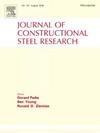改进型多孔 T 型混凝土填充钢管的双轴偏心行为
IF 4
2区 工程技术
Q1 CONSTRUCTION & BUILDING TECHNOLOGY
引用次数: 0
摘要
近年来,异形混凝土填充钢管(CFST)结构引起了学者们的极大兴趣。然而,对多单元 T 型 CFST(MT-CFST)柱的研究关注有限,导致计算方法缺乏统一性。本文提出了一种改进的 MT-CFST 柱,由三根矩形钢管、一块钢板和混凝土组成。这种设计可确保焊缝避开钢管的冷弯区,从而提高焊缝质量。在实际工程应用中,支柱经常会承受双轴偏心载荷。对 15 个 MT-CFST 试样进行了双轴偏心压缩试验。本研究探讨了偏心率、偏心角和腹板高度对 MT-CFST 柱性能的影响。实验结果表明,各试样的失效模式相似:在峰值载荷之前,都出现了轻微的弯曲变形。对于 T56.6-60-45° 和 T40-90-180° 试件,由于受压侧钢板的宽厚比较小,防止了局部屈曲。其他试样在靠近中跨部分的受压侧出现了轻微的局部屈曲。在峰值荷载之后,局部屈曲逐渐加剧,这主要是由于大量的弯曲变形造成的。试样的破坏归因于局部屈曲和整体弯曲变形。当偏心距大于 20 毫米时,试样的承载能力和弹塑性刚度随着偏心角的增大呈先增大后减小的趋势,峰值出现在 90°左右。受压侧位于凸缘的试样具有更高的承载能力和弹塑性刚度。此外,还建立了 FE 模型来模拟双向偏心行为。以极限条件下的截面应力分析为基础,开发了一种计算抗弯能力的简化方法。根据 ANSI/AISC 360 标准,建立了预测单轴偏心承载力的方法。通过对 Mx/Mux,n-My/Muy,n 曲线进行参数分析,提出了一种确定 Mx/Mux,n-My/Muy,n 曲线的简化方法,计算结果与 FE 结果十分吻合。本文章由计算机程序翻译,如有差异,请以英文原文为准。
Biaxial eccentric behavior of improved multi-cell T-shaped concrete-filled steel tubes
The special-shaped concrete-filled steel tube (CFST) structure has attracted considerable scholarly interest in recent years. However, limited attention has been given to research on multi-cell T-shaped CFST (MT-CFST) column, resulting in a lack of uniformity in calculation methods. This paper presents an improved MT-CFST column composed of three rectangular steel tubes, a steel plate, and concrete. This design ensures that welds avoid cold bending zones in steel tubes, thereby enhancing quality of welds. In practical engineering applications, columns often experience biaxial eccentric loads. A biaxial eccentric compression test was conducted on fifteen MT-CFST specimens. This study investigated the influence of eccentricity, eccentric angle, and web height on performance of MT-CFST column. The experimental results revealed a similar failure mode among specimens: prior to peak load, minor bending deformation was observed. For specimens T56.6–60-45° and T40–90-180°, the smaller width-to-thickness ratio of steel plates on compressed side prevented local buckling. For other specimens, slight local buckling on compressed side near mid-span section was observed. After peak load, local buckling progressively intensified, primarily due to substantial bending deformation. The failure of specimens was attributed to local buckling and overall bending deformation. For eccentricity greater than 20 mm, the bearing capacity and elastic-plastic stiffness of specimens exhibited an increasing trend followed by a decreasing trend with the increase in eccentric angle at the same eccentricity, with the peaks occurring at around 90°. Specimens with the compressed side located at flange demonstrated higher bearing capacity and elastic-plastic stiffness. Additionally, FE models have been established to simulate the bidirectional eccentric behavior. A simplified method for calculating flexural capacity was developed, grounded in stress analysis of section at ultimate conditions. In accordance with ANSI/AISC 360, a method was established for predicting uniaxial eccentric capacity. By conducting a parametric analysis of Mx/Mux,n-My/Muy,n curves, a simplified method for determining Mx/Mux,n-My/Muy,n curves was proposed, with calculation results in good agreement with FE results.
求助全文
通过发布文献求助,成功后即可免费获取论文全文。
去求助
来源期刊

Journal of Constructional Steel Research
工程技术-工程:土木
CiteScore
7.90
自引率
19.50%
发文量
550
审稿时长
46 days
期刊介绍:
The Journal of Constructional Steel Research provides an international forum for the presentation and discussion of the latest developments in structural steel research and their applications. It is aimed not only at researchers but also at those likely to be most affected by research results, i.e. designers and fabricators. Original papers of a high standard dealing with all aspects of steel research including theoretical and experimental research on elements, assemblages, connection and material properties are considered for publication.
 求助内容:
求助内容: 应助结果提醒方式:
应助结果提醒方式:


